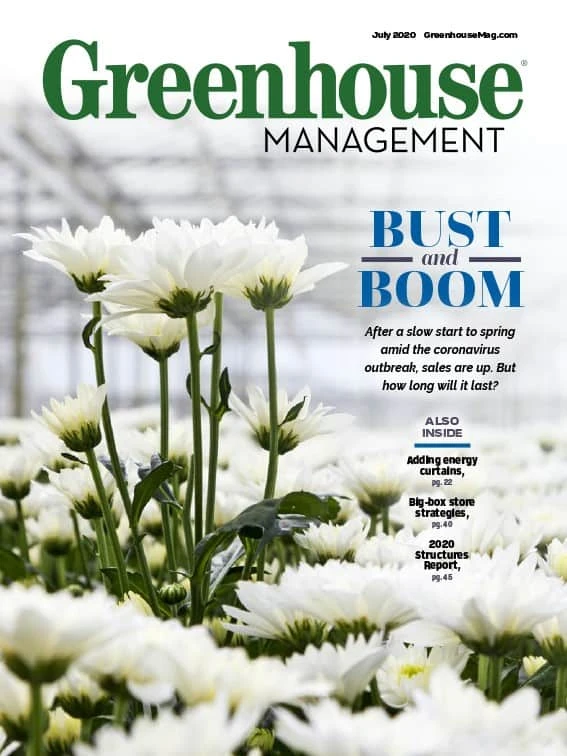

While walking through 2 million square feet of production space at Skagit Horticulture in Mount Vernon, Washington, operations manager Corey Hill loves to see flats of plants pulled off to the side, undergoing various trials.
“That makes me happy because it means we’re trying to grow better and do something different,” he says. “I’m trying to provide that freedom to growers to be able to experiment, because we’re always looking for a better way to grow in the future.”
Committed to continuously enhancing the wholesale greenhouse’s operation, Hill encourages growers to look for opportunities to improve every day. Here’s how he does it.
Lean greenhouse
Hill started working at a retail greenhouse during high school to earn gas money, but “I had such an awesome experience, it made me not want to ever do anything else,” he says. After earning his botany degree, he worked at the greenhouse for a few more years until he met his wife there. They decided to move west and pursue horticulture careers in Washington, where she started working at Northwest Horticulture and he got a job at Skagit Gardens.
Hill spent about 10 years at Skagit Gardens before taking a head grower position at Van Wingerden Greenhouse. But then, a few years into that role, Northwest Horticulture ended up buying Skagit Gardens — merging to form Skagit Horticulture in 2017.

Who better to help align the newly joined teams at Skagit? “I was in a unique position where I knew people on both sides, so I had the opportunity to come back and help bridge them together,” Hill says.
Hill relied on his experience with lean manufacturing principles, which focus on minimizing waste while maximizing productivity. Rather than approaching any task, like transplanting, in terms of “our” way versus “their” way, Hill worked with the team to design more efficient processes together.
“We would sit down and talk through the process with the workers that were actually doing the job,” Hill says. “I can go in and tell them my way, but if it doesn’t end up being their idea, it won’t last long before they revert back to the old way. By building a whole new process, it allows the people doing the work to be the ones that decide how to do it.”
Free to experiment
After the merger, Hill stepped into the head grower role and then, in March 2018, he was promoted to operations manager. Now, he continues using lean principles every day to manage the operation.

“As operations manager, I do very little growing of plants,” he says. “I’m learning what all the other departments are doing and making sure my team stays in the loop so we can adjust what we’re doing. One of my main jobs is to remove barriers that are holding people back to keep the big picture in focus.”
Under the brand umbrella of Skagit Horticulture, the company caters to several distinct markets. It serves as the plug and liner division supplying other growers, while Skagit Gardens serves small independent garden centers, Northwest Horticulture serves large big-box retailers and a commercial agriculture division grows crops like grapes, hops, fruit and berries. Spanning four facilities in Washington and one in California, Skagit fills more than 2 million square feet of production space on 650 total acres.

Hill is based at the main location in Mount Vernon, Washington. Although he has “some oversight over the other locations, they’re currently running somewhat independently,” he says. In fact, he encourages his growing team to exercise independence regularly by setting up small trials to test regulators or other applications.
“We’re constantly trying new things,” he says. “If you were walking in our field, you’d stumble upon a randomized group of plants organized into a pre-emergent herbicide trial, where the growers grabbed one of everything and sprayed it with three different herbicides over the winter to see which one worked best and which plants liked it.”
Of course, the team stays in constant contact with Hill to make sure they’re trialing chemicals that are available and affordable, but other than that, “they’re completely independent,” Hill says. “That’s the funnest part of being a grower, is watching what kind of changes you can make and how it affects the crop.”
Change for the better
Although this spring has introduced unprecedented new challenges beyond the industry’s control, Hill says the mark of a successful grower is his ability to adapt and make changes in response to obstacles. The best growers keep driving change with the goal of producing better crops more efficiently.
“Most growers can’t make changes fast enough,” he says, “but you have to have the patience to make sure that change is sustainable.”

Explore the July 2020 Issue
Check out more from this issue and find your next story to read.
Latest from Greenhouse Management
- Flexible fungicides
- Super Charged Moon Juice from Moon Valley Nurseries now available nationally
- 2025 Proven Winners Horticulture Scholarship applications now open
- How to improve inventory and shipping management in the greenhouse
- Leading Women of Horticulture: Anna Ball, Ball Hort, and Terri McEnaney, Bailey Nurseries
- GM CEA HERB Part 2: A guide to increasing the sowing density of culinary herbs
- GM CEA HERB Part 1: Best practices for producing culinary herbs in controlled environments
- USDA fires experts on invasive pests, including Asian citrus psyllid, chilli thrips





